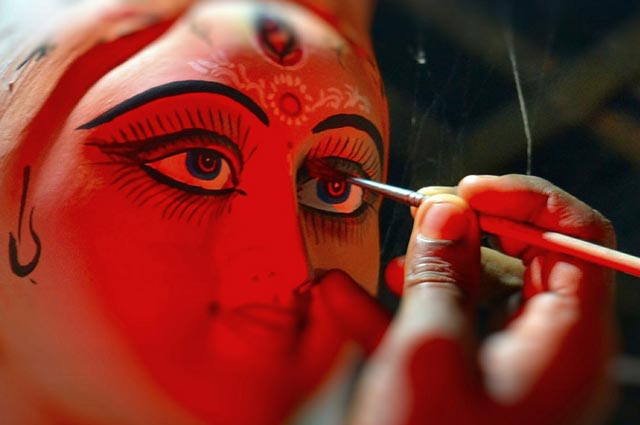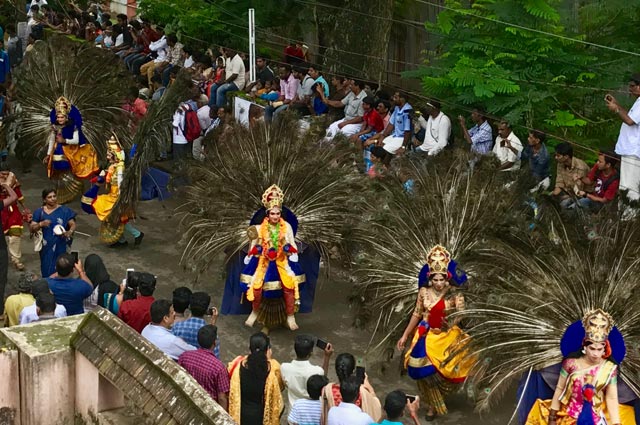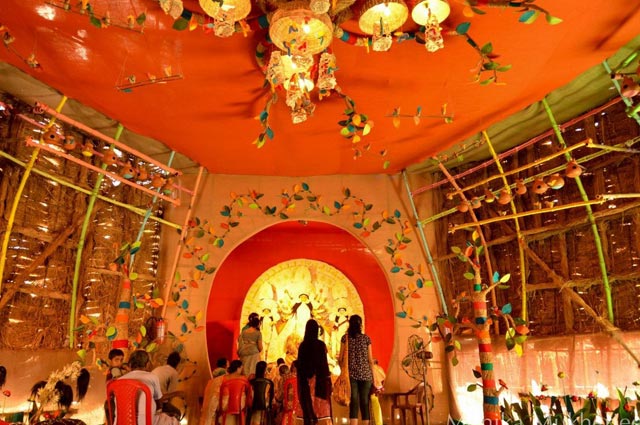
- By Theme
-
Destinations
-
Indian Destinations
-
International Destinations
-
- Best Places to Visit
- Packages
- Search Agents

"And when she glared at Mahishasura, he was terrified to see her valiant form. Despite making numerous efforts of running away, he finally took his last breath when the trident pierced his chest."
Jai Mata Di, dear readers. The glory of Goddess Durga, the slayer of demons is simply beyond description. The destructive form of the Goddess killed Mahishasura, a demon, with a boon of being next to an immortal as no man or God could kill him. Each year, in the honor of the Goddess, the pious festival of Durga Puja is celebrated by the Hindus, especially in West Bengal. This festival is also known by the name of Navaratri and is celebrated with a great zest. People enjoy merrymaking, sing & dance, and pray for the well-being of the entire human race. The festival of Durga Puja in India lasts for nine days where different ceremonies are conducted. Here are some grand preparations of the festival that have a deep meaning. Take a look at them.

The day of Chokkhu Daan marks the commencement of Durgotsava. It is observed a week before Durga Pooja. According to legends, Goddess Durga was invited on Earth and the day is known as Mahalaya. On this auspicious day, the potters begin painting the eyes on the idols of the goddess. All the idols of the deity are carved and crafted in the region known by the name of Kumartuli. Located merely a few km away from the main town of Kolkata, Kumartuli is a colony that was established by a group of potters in the previous times. At present, more than 120 families reside at Kumartuli.

Bringing the deity into the house or pandal is not less than a mini-carnival. The devotees dress up in the traditional attire to bring the Goddess in their exquisitely festooned locale. The entire procession is carried in a grand manner and is accompanied with the idols of Lord Shiva, Lord Kartikeya, and Lord Ganesha. People prefer various types of processions for the consecration of the idol of Goddess Durga. Some carry the procession in a simple manner, whereas, some choose a grand way to make it an indelible moment. Throughout the journey, the devotees sing and dance that continues till the idol has been installed facing towards East inside the house or in the pandal.

Prana Pratishta is another major ritual conducted before worshiping Goddess Durga. When the idol is brought and consecrated, it is kept under a veil. The deity is unveiled by chanting the Holy mantras and sprinkling holy water. Later on, the idol is bathed with panchamrit. The feet of the idol are washed with water. After this ritual, the regular aartis are conducted for the next 9 days. The head priest of the shrine conducts the rituals twice a day. Since Goddess Durga is pampered like a guest in these days, her devotees make various offerings, most probably fruits, that is distributed among people as an offertory.

Dashami is the last day of Durga Pooja in India. This is the day that marks the end of the festival. On this day, the idols everywhere are adorned with the new clothes, worshiped, and carried out in the procession. The devotees of the Goddess celebrate this by carrying out a procession, singing, and dancing before they immerse the idol in the water body. On this day, devotees, especially women, perform the traditional aarti dance in front of the Goddess and apply vermillion and red color on each others face. It marks the victory of Goddess Durga over the demon Mahishasura. The adieu songs are sung in the local language as the idol is immersed. It is believed that Goddess Durga reaches back to her abode after the clay dissolves in water.

The prime highlights of Durga Puja celebration in India are pandals, decorations, and food. Since this festival is celebrated on an extensive scale, everyone wished their decorations to be unique and outstanding. They are ornamented in an appealing manner as they are lit beautifully with lights. Thus, the pandals are created according to a theme. In the present-day scenario, the theme of a pandal is created that conveys a social message. It is all accomplished by collecting funds from the local areas.
The food during Durga Pooja is something that cannot be missed. Apart from the offertory, people follow a strict vegetarian diet. They quit crunching the Taamsik Aahaar and consume the Saatvikk Aahaar. The community kitchens are organized and the delectable other snacks like malpua, murmura, khoya barfi, rajbhog etc. are also eaten on a wider scale.
The celebration of the festival of Durga Puja is intriguing. The divinity of the nine days dedicated to Mother Goddess is truly enchanting. Devotees relish some special moments and do not forget to ensnare them forever in the lens of the camera. If you have enjoyed any of the above-listed events, do not hesitate in sharing them with us.